The Advanced Passenger Train

The Advanced Passenger Train is frequently quoted as one of the Great British Non-Starters of our time. But was it ?
This isn't the original text: we didn't have HTML in 1993. I've also corrected a few points and added extra details!
>>Only one APT set has survived, and is "preserved" at Crewe in the Heritage Centre,
>I remember seeing one at the York railway museum about two years ago, is
>it still there? It was in a bit of a state.
 That's a different train: the APT-E. "E" stands for
"Experimental", and the APT-E was the technology proving
train. It never ever ran in passenger service and was a completely
different beast from the production train. APT-E was only four cars
long: two gas turbine power cars, and two trailers chock full of
instrumentation. It ran regular tests in several places, but
particularly on the Midland Main Line and the Old Dalby Test Track.
It achieved its maximum of 152.3 mph on the Great Western. You're probably familiar with the photograph of a prototype Concorde
making a low pass over the GW main line near Filton as the APT-E passed
underneath. What a fluke that must have been for the photographer — I
just cannot imagine it being set up! And, too, there are photo's of the
APT-E and the experimental HST (41 001 + 41 002, later numbered as a
multiple unit 252 001) side by side at Swindon.
That's a different train: the APT-E. "E" stands for
"Experimental", and the APT-E was the technology proving
train. It never ever ran in passenger service and was a completely
different beast from the production train. APT-E was only four cars
long: two gas turbine power cars, and two trailers chock full of
instrumentation. It ran regular tests in several places, but
particularly on the Midland Main Line and the Old Dalby Test Track.
It achieved its maximum of 152.3 mph on the Great Western. You're probably familiar with the photograph of a prototype Concorde
making a low pass over the GW main line near Filton as the APT-E passed
underneath. What a fluke that must have been for the photographer — I
just cannot imagine it being set up! And, too, there are photo's of the
APT-E and the experimental HST (41 001 + 41 002, later numbered as a
multiple unit 252 001) side by side at Swindon.
The train which did run in service was the APT-P, for "Prototype". There were three full trains, each composed of two identical half trains of driving trailer, six (I think) articulated cars and a non-driving electric Bo-Bo power car. The two power cars were formed in the middle of the train because, at the time they were designed, pantograph technology wasn't up to having two pans at opposite ends of the train both working at the 150mph envisaged for the train.
By the time they reached passenger service one half of each train had been reduced to just driving trailer plus power car because it wasn't economical to provide two full sets of staff — there was no access between the two halves except via a cramped, noisy walkway through the guts of the power cars.
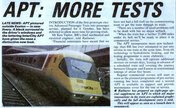 Launch was originally set and publically announced for May 1980, but
technical problems meant several delays to the date. After it was again
delayed from May 1981, to September and
then October
Launch was originally set and publically announced for May 1980, but
technical problems meant several delays to the date. After it was again
delayed from May 1981, to September and
then October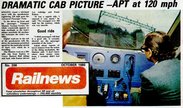 , the date was eventually set
by fiat, and testing and tuning continued right up until Monday 7th December 1981, when APT-P was introduced to a blaze of
publicity.
, the date was eventually set
by fiat, and testing and tuning continued right up until Monday 7th December 1981, when APT-P was introduced to a blaze of
publicity.
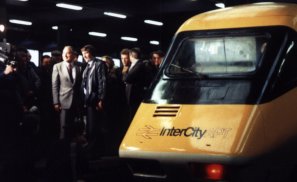
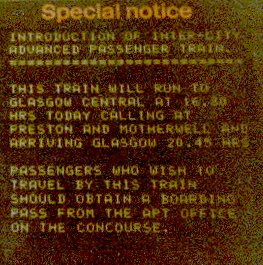
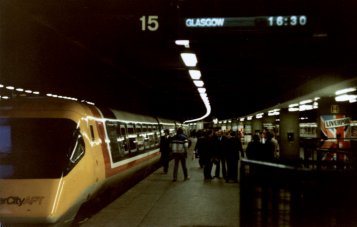 APT achieved, if I remember right, a maximum of 140mph southbound
and about 138 northbound. As noted by another poster, journalists looking for
a story exaggerated the nausea problem, nobody I spoke to found any problems with it.
I even went to the extent of standing up round reverse curves.
Later trials proved that some
people did genuinely experience it; it was mainly due to the fact that
the tilt mechanism compensated too perfectly for the sensations
of cornering. But the train did suffer two or three stops due to minor tilt failures
during the trial run, which didn't help its credibility either. Nor did
an unauthorised stop at Carstairs on the return journey to set down the
minor television personality Isla St. Clair. I think despite all the delays we were about 40
minutes late into Glasgow, which meant the trip took the same time as a
normal train :-)
APT achieved, if I remember right, a maximum of 140mph southbound
and about 138 northbound. As noted by another poster, journalists looking for
a story exaggerated the nausea problem, nobody I spoke to found any problems with it.
I even went to the extent of standing up round reverse curves.
Later trials proved that some
people did genuinely experience it; it was mainly due to the fact that
the tilt mechanism compensated too perfectly for the sensations
of cornering. But the train did suffer two or three stops due to minor tilt failures
during the trial run, which didn't help its credibility either. Nor did
an unauthorised stop at Carstairs on the return journey to set down the
minor television personality Isla St. Clair. I think despite all the delays we were about 40
minutes late into Glasgow, which meant the trip took the same time as a
normal train :-)
 However the major problem was that the night of 7th-8th December
brought some of the worst winter weather for several years to the whole
of England. During the following three days British Rail tried to continue the
APT service, but — as with most other stock on the network — moisture
kept freezing, not in the high-speed hydraulic brakes, but in the air
brake lines which were supposed to take over at lower speeds. On the
Wednesday the southbound trip was cancelled at Crewe, amongst service
problems all around, and the train withdrawn from passenger service.
However the major problem was that the night of 7th-8th December
brought some of the worst winter weather for several years to the whole
of England. During the following three days British Rail tried to continue the
APT service, but — as with most other stock on the network — moisture
kept freezing, not in the high-speed hydraulic brakes, but in the air
brake lines which were supposed to take over at lower speeds. On the
Wednesday the southbound trip was cancelled at Crewe, amongst service
problems all around, and the train withdrawn from passenger service.
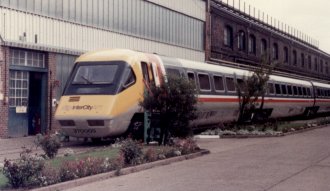 As far as the media were concerned that was the end of the APT. However
the engineers kept working on tuning the tilt mechanism, or rather
carefully de-tuning it to give the most sensitive passengers a sense of balance.
And in summer 1982 the APT was very quietly reintroduced to service. At first
it ran as a relief train shadowing a normal service; later, as
confidence grew, it gained its own departure slot, about 10.30 from
Glasgow and an early evening return from Euston if I remember. I
travelled on it several times between 1982–1984 and the ride was quite
superb and the reliability exemplary. I deeply regret though that,
photographically speaking, it was a bit of a 'jinx train' for me. I have many
feet of badly-exposed film of it due to undetected camera failures or wrong exposure settings.
As far as the media were concerned that was the end of the APT. However
the engineers kept working on tuning the tilt mechanism, or rather
carefully de-tuning it to give the most sensitive passengers a sense of balance.
And in summer 1982 the APT was very quietly reintroduced to service. At first
it ran as a relief train shadowing a normal service; later, as
confidence grew, it gained its own departure slot, about 10.30 from
Glasgow and an early evening return from Euston if I remember. I
travelled on it several times between 1982–1984 and the ride was quite
superb and the reliability exemplary. I deeply regret though that,
photographically speaking, it was a bit of a 'jinx train' for me. I have many
feet of badly-exposed film of it due to undetected camera failures or wrong exposure settings.
But, though the train was technically a success, the political battle had been lost and the management will to build the APT-S
("Squadron") had evaporated. Eventually it was withdrawn from
service; two trains were scrapped and one sent to Crewe Heritage Centre
(now The Railway Age)
where from time to time the newspapers rediscover
"BR's Wonder Train Shunted Into
History".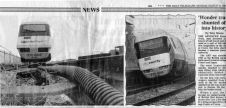
Links on this site:
- Railnews: APT: More Tests
- Railnews: Cab Picture — APT at 120mph
- Daily Telegraph: "BR's Wonder Train Shunted Into History"
